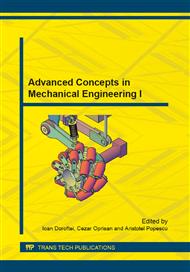p.626
p.632
p.638
p.644
p.648
p.654
p.660
p.666
p.672
Development of a Quality Indicator System for Haptic Exoskeleton Modules
Abstract:
The accuracy of outer space robotic applications using haptic devices requires high performance of the haptic device connected with the remote robot. The paper introduces and develops a quality indicator system, able to give overall information on the performances of the haptic device. The authors define several categories of indicators, such as the geometric, kinematic and dynamic. The geometric category comprises the position and orientation accuracy, the repeatability, the trajectory fluctuation, the resolution, the working space and the static relaxation. The kinematic indicators category comprises the speed fluctuation, the maximal acceleration and time accuracy. The dynamic indicators category comprises the force and torque fluctuation, the vibration amplitude and acceleration. All above-mentioned simple indicators open the path to complex indicators such as the pose accuracy in relation with the working space or the maximum force/torque in respect with the total weight. By introducing moderated indicators, the authors consider the specificity of each group of tasks or applications and in the end, they introduce a global moderated indicator in order to quantify rapidly the general performance level of a certain haptic device.
Info:
Periodical:
Pages:
648-653
Citation:
Online since:
October 2014
Keywords:
Price:
Сopyright:
© 2014 Trans Tech Publications Ltd. All Rights Reserved
Share:
Citation:


